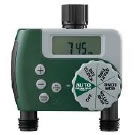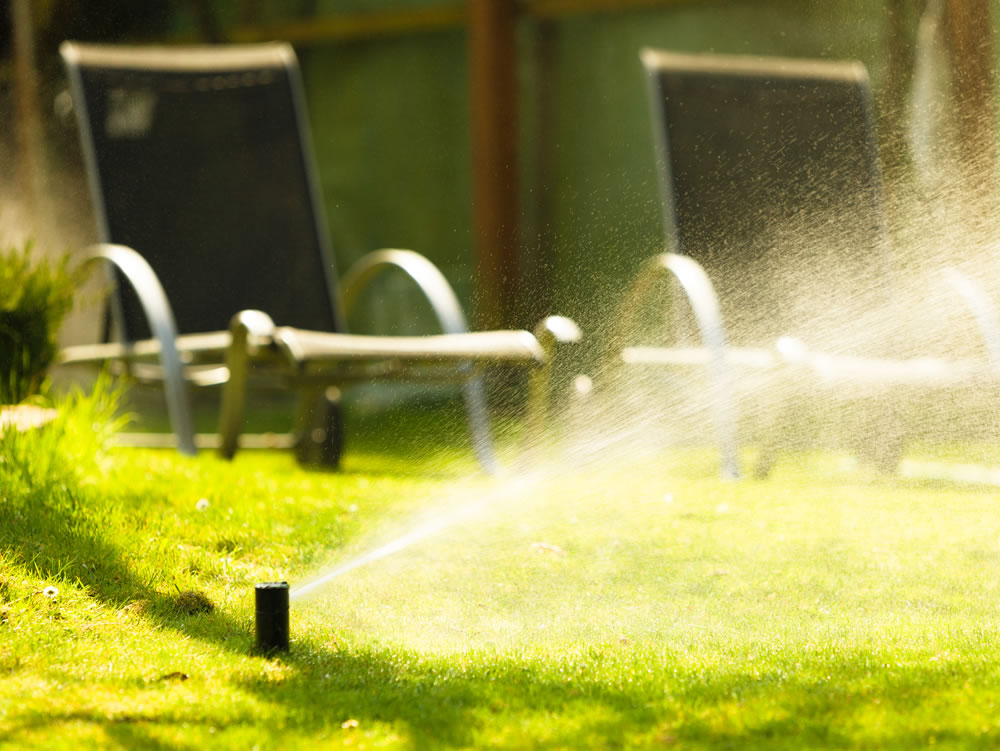How to Properly Establish Grass from Seed—
This step by step watering guide will provide you with maximum germination and establishment of new grass seed. It’s simple, effective and proven to get results.

This is a before and after picture of my lawn last fall. The guide I have outlined for you below is the exact watering schedule I use on my lawn to achieve these results. This guide is based from a decade of experience operating Five Star Lawn Care, LLC.
Proper watering = Results
Items Mentioned in this Guide:
Neverkink Watering Hoses
Pulsating Sprinklers
Automated Irrigation – Watering Timers
Rain Gauge – Water Distribution Measurement
1. When to Start Watering
A. Installation of watering hoses, timers and sprinklers should be set up immediately following the completion of the lawn being aerated and seeded and the initial watering should begin.
2. Sprinkler Set-Up
A. When setting up your sprinklers, locate as many hoses and sprinklers as possible. You may need to purchase additional hoses and sprinklers to ensure full coverage of entire lawn areas. It is important to note that any area of the lawn not provided with irrigation will NOT germinate or establish.
3. Selecting the Right Sprinklers
A. Pulsating sprinklers, also known as impact sprinklers are the leading above ground sprinklers due to the fact that they are adjustable creating versatility in a variety of landscape situations are a simple, effective design which means fewer parts to break or have something go wrong.
An additional benefit of pulsating sprinklers is the fact that they also have the largest coverage area over other sprinklers which means less out of pocket costs to cover the same area of lawn.
Quick word of caution: Stay away from anything plastic when selecting your sprinklers. The plastic sprinklers will not last a season before they break and the performance is terrible due to the lack of weight needed to create the pulsating motion that the impact sprinkler relies on in order to distribute the water effectively. They “can” work but require high levels of consistent water pressure or they will hang up and just flood the lawn, washing seed away and causing uneven germination – something we definitely want to avoid!
4. Automate your Irrigation
To avoid the hassle of turning sprinklers on/off, etc. — the most effective way to ensure your newly seeded lawn is properly watered at the proper intervals is by utilizing one or more Digital Water Timers. In fact, to properly water a newly seeded lawn, it’s nearly impossible to do this manually without either an in-ground irrigation system or some type of above ground system, and that’s where these simple, but effective digital water timers come to the rescue!

A digital watering timer like the one pictured above can be purchased on Amazon. They are available with single, double, triple or even quadruple watering outlet ports depending on how many hoses and sprinklers need to be operated per water spigot. Orbit brand models won’t break the bank and will serve our purpose of watering automation.
Single outlet timers are useful for very small lawns that only need one sprinkler for complete coverage. We’re talking a lawn 4,000sqft or less. That being said, it is usually a better idea to opt for the dual outlet timer or greater. The additional outlet(s) allow operation of more hoses and sprinklers giving you additional options for future needs.
Sprinkler water coverage should overlap at edges to ensure proper water coverage. When setting up your sprinklers remember any area not receiving water will NOT germinate and grow. Once the initial watering or rainfall has taken place, the seed MUST remain moist and not be allowed to dry out. This will ensure the highest possible germination rates of new seed.
5. Frequency of Watering Applications – First 3 weeks
A. Upon starting the watering schedule, the entire lawn area MUST receive light, but frequent watering every day. any area not getting watered will NOT germinate. Once the initial watering or rainfall has taken place, the seed MUST remain moist and not be allowed to dry out to ensure proper germination.
B. Each sprinkler will vary in application rate, however generally 7 minutes per sprinkler 3 times per day is sufficient. For example, select on Orbit watering timer’s dial to “Start Time” at 5am. Set “How Long” for 7-10 minutes. Set “How Often” for every 8 hours. Turn dial to “Auto” and ensure water spigot is turned on and your lawn will now be watered automatically per your settings. Easy, right?
These settings will be used for ONLY the first 3 weeks or until new grass reaches a height of 3 inches. Germination of cool season tall fescue grass usually takes 7-10 days (before you see green sprouts over your lawn area) and 3” height around 21 days.
C. The lawn area should be evenly watered over the entire sprinkler area. Some sprinklers have adjustments and others do not. The key is even water distribution. You do not want “rings” of heavy watering around the sprinkler heads. This will cause uneven germination. This is the main reason pulsating sprinklers are preferred over others. Also ensure that fittings on all hoses and sprinklers are firmly fastened so no water is leaking which can also lead to uneven germination.
D. Water ALL lawn areas each and every day utilizing watering schedule similar to the above outline. Continue daily watering UNTIL the new seeds germinate and grow to 3 inches. This height can be expected in approximately 21 days for tall fescue grass if proper watering schedule is followed.
6. New Water Schedule – After First Lawn Mowing
A. Up to this point you should have watered your lawn 3 times per day, every 8 hours for 7-10 minutes each sprinkler. Now the turf grass will begin to help to shade the soil, which will help to retain soil moisture. You should now water your entire lawn EVERY OTHER day, but watering frequency should be reduced from 3 times per day to 2 times per day. Run time per sprinkler will be 20 minutes now instead of 7-10 minutes.
B. You should continue to water your lawn every other day until the second mowing, which will be completed 4-5 weeks after the initial watering of the lawn has taken place. When your lawn is ready for the second mowing, once again allow the lawn to dry out for 48 hours prior to mowing. This may mean setting up your lawn watering days with a little foresight to have the off day land on the day that the lawn is normally mowed.
C. You may now reduce your watering back to EVERY THIRD day. Continue this schedule until your lawn is full. Remember not to mow your lawn or walk on it when it is wet.
Important Irrigation Facts:
The reason we do not continue watering the lawn every day is that the lawn only requires daily watering for the germination phase when establishing grass from seed.
Failure to adjust watering up to the point of every third day will cause the grass to be hindered from establishing deep roots if never challenged to search for deeper sources of soil moisture due to being watered daily.
This will lead to lack of drought tolerance during the summer and an overall weaker turf.
As a rule of thumb, the lawn once established needs 1 – 1.5” of irrigation or per week to thrive. Use a common rain gauge to determine how long your particular sprinkler set up takes to water the lawn 1” and divide this total time to be run every 3 days and adding together to produce 1-1.5” of water per week.
Water in the early morning between 5-7am to allow soil to soak in moisture and avoid unnecessary evaporation and wasted irrigation. Evening watering will cause moisture to sit on grass all night leading to fungus and disease issues.
Final Summary:
Failure to follow a watering schedule like the guide outlined above will result in a lawn short of its full potential. The most common mistake I have seen homeowners make over the years is thinking that watering every day is the best thing for their lawn. Please note that there are different phases of grass development requiring differing watering frequency and watering run times. The irrigation requirements are dependent upon the specific phase of grass establishment such as germination, young grass seedling or fully matured.
Item Checklist :
Neverkink Watering Hoses
Pulsating Sprinklers
Automated Irrigation – Watering Timers
Rain Gauge – Water Distribution Measurement


Greetings from Ohio! I’m bored to death at work so I decided to browse your site on my iphone during lunch break.
I love the info you present here and can’t
wait to take a look when I get home. I’m surprised at how quick
your blog loaded on my phone .. I’m not even using WIFI,
just 3G .. Anyhow, wonderful site!
Thank you for the kind words. I am glad you found my watering guide helpful. Thanks and have a Five Star day!
Thank you for your kind feedback, I greatly appreciate it!
I have been exploring for a little bit for any high-quality articles or weblog posts in this kind of space .
Exploring in Yahoo I finally stumbled upon this website.
Studying this info So i am glad to express that I have a very good uncanny feeling I found out exactly what I needed.
I so much definitely will make certain to don?t fail to remember this site and give it a look
on a constant basis.
So glad you found what you are looking for and that I could help you with your lawn care needs. Stay tuned for more to come.
Hmm it appears like your site ate my first comment (it was super long) so I
guess I’ll just sum it up what I submitted and say, I’m thoroughly enjoying your blog.
I too am an aspiring blog writer but I’m still new to the whole thing.
Do you have any points for first-time blog
writers? I’d definitely appreciate it.
Thank you for reaching out and I am thrilled to know you are enjoying my blog. I would recommend that you write what you love and know. The article information will come naturally and flow smooth and take much less time to put together. Don’t be afraid to have a rough copy of your blog post come out first because that is exactly what the first draught will be — a rough draft. Once you get that out, condense it as much as possible and remove any non-necessary items to make the reading and information gathering of your site visitor as simple as possible. Then just polish it up, and post! Rinse and repeat. Hope that helps you!
Hi Kassie, thank you for your comment. I recommend only writing about topics you are very familiar with or first doing ample research first. Try to put yourself in your reader’s shoes and ask yourself the question, what would be of most value to them? Put yourself together 3-5 good points to write about and just get writing! Eliminate distractions while writing. Understand your first draft is going to suck but it will be the foundation for the house to be built. You can add the windows and doors and fancy trim to your blog post later but first, you need to lay the foundation and that is the rough draft. I just write my rough draft and then edit from there until I am satisfied before moving on to the next post. Hope that helps!
Thanks for the article.Really looking forward to read more.
Whats the difference between seeding and overseeding?
Great question! Seeding and overseeding are often used interchangeably.
In the green industry, we normally refer to a bare area as needing to be “seeded” and a previously established turfgrass area as needing to be “overseeded” since with grass already established we would be “seeding over” the current grass that is there.
I would not recommend seeding or overseeding your entire lawn without first knowing the grass type you have, cool or warm-season variety, do you know?
Once we have the correct grass type we can determine the growing habits of that grass and when it when to have the lawn aerated and seeded or “overseeded”. Core aeration needs to be completed to prepare the soil for the new grass and should always be done when the turf type (whether warm or cool-season grass) is actively growing.
For cool-season grass, the active growing season is in the fall and for warm-season grass, the active growing season is in the summer after the warm-season grass has “greened up” and is vigorously growing.
Then, once you know this information, you can move onto the correct timing to core aerated the lawn.
Core aeration allows the lawn oxygen, water, and nutrients to the root system of turfgrass. This service will loosen compacted soil allowing grass to establish deeper and stronger root systems by accessing increased oxygen, moisture, and nutrient levels.
Core aeration will also prepare the soil for seed and is the step that should be done first before seeding or overseeding. I discuss core aeration and seeding in this video I did on my Youtube channel. You can subscribe here for pro tips, time/money-saving guides, giveaways, and more.
I can provide even further detailed information if you provide a bit of info such as:
1) What grass type do you have?
2) What area do you live?
3) What is your climate like in your area?
The differently colored arms and noses of the
moles makes them really interesting, and makes
me think twice about what moles look like.
This is a great blog and I did learn something from this which made it worth reading. I just did a fall aeration and over seed. My soil is soil clay so I had to find the proper seed 1st that would grow in this soil and withstand summer droughts. But this past fall in 2020 I spent 3 days watering trying to get enough water in the soil to pull the proper 3” plugs. After reading this timer and choice of sprinkles is what stood out to me. Because what I used was oscillating sprinklers before aeration and after over seeding. Basically I was married to my lawn for a month dragging garden hoses and it was very time consuming. Thanks again for these tips it’s very helpful and something I will apply next year. TY
Jeff, thanks again for taking the time to share your thoughts. Always great to hear from you! Clay is predominately what we work within Charlotte, NC. What area of the country are you from? And you are absolutely correct! The very reason I wrote this guide was to ensure my clients get the best lawn for their money by having us renovate it. I also wrote this guide because most people cannot stay home all day moving sprinklers around and I have learned, if it’s too complicated, people will do something else or neglect it altogether. This guide was my attempt to streamline my client’s life while saving them time and getting better results. If you like my content and would like to stay connected, you can subscribe here to the Five Star Lawn Care Youtube channel for pro tips, DIY videos, exclusive offers, giveaways, and more. Let me know if I can help with anything.
Tame the wild,
Riley Adkins, President
US Marine Veteran